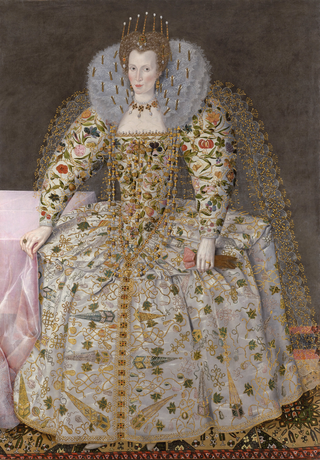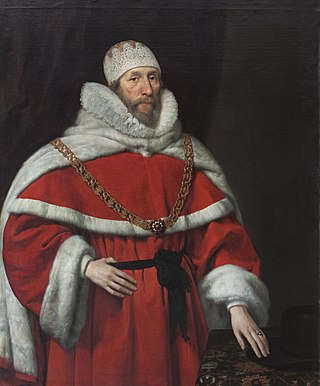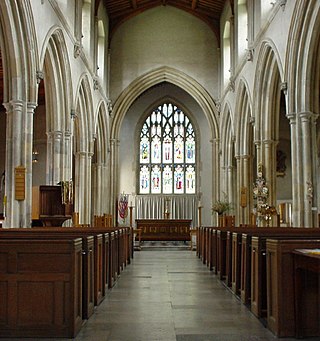Related Research Articles
The Master-General of the Ordnance (MGO) was a very senior British military position from 1415 to 2013 with some changes to the name, usually held by a serving general. The Master-General of the Ordnance was responsible for all British artillery, engineers, fortifications, military supplies, transport, field hospitals and much else, and was not subordinate to the commander-in chief of the British military. In March 2013 the holder was titled as "Director Land Capability and Transformation", but still sat on the Army Board as Master-General of the Ordnance; in September 2013 the post was eliminated.
The Treasurer of the Household is a member of the Royal Household of the Sovereign of the United Kingdom. The position is usually held by one of the government deputy Chief Whips in the House of Commons. The current holder of the office is Mark Tami MP.
This is an incomplete list of people who have served as Lord Lieutenant of Norfolk. Since 1689, all Lord Lieutenants have also been Custos Rotulorum of Norfolk.

Catherine Howard, Countess of Nottingham, was a cousin, lady-in-waiting, and close confidante of Elizabeth I of England. She was in attendance on the queen for 44 years.
This is a list of people who have served as Custos Rotulorum of Norfolk.

Sir Henry Hobart, 1st Baronet, of Blickling Hall, was an English politician who succeeded Sir Edward Coke to become Chief Justice of the Court of Common Pleas.
The high sheriff is the oldest secular office under the Crown and is appointed annually by the Crown. The High Sheriff of Norfolk was originally the principal law enforcement officer in Norfolk and presided at the assizes and other important county meetings. Most of the responsibilities associated with the post have been transferred elsewhere or are now defunct, so that its functions are now largely ceremonial. There was a single high sheriff serving the two counties of Norfolk and Suffolk until 1576.
Norfolk was a County constituency of the House of Commons of the Parliament of England from 1290 to 1707, then of the Parliament of Great Britain from 1707 to 1800 and of the Parliament of the United Kingdom from 1801 to 1832. It was represented by two Members of Parliament. In 1832 the county was divided for parliamentary purposes into two new two member divisions – East Norfolk and West Norfolk.
This is a list of Sheriffs of Norfolk and Suffolk. The Sheriff is the oldest secular office under the Crown and is appointed annually by the Crown. He was originally the principal law enforcement officer in the county and presided at the Assizes and other important county meetings. After 1576 there was a separate Sheriff of Norfolk and Sheriff of Suffolk.
William Paston, 2nd Earl of Yarmouth FRS of Oxnead, Norfolk and Turnham Green, Chiswick, Middlesex was a British peer and politician.

Sir Roger Townshend was an English nobleman, politician, soldier, and knight. He was the son of Sir Richard Townshend and Katherine Browne. He spent much of his career in the service of Thomas Howard, 4th Duke of Norfolk, and Norfolk's son and heir, Philip Howard, 20th Earl of Arundel. He was knighted at sea on 26 July 1588 during the battle against the Spanish Armada.
Sir John Townshend MP, of Raynham Hall in Norfolk, was an English nobleman, politician, and knight. He was the son of Sir Roger Townshend and Jane Stanhope. He was also a soldier and Member of Parliament. He was killed in a duel with Sir Matthew Browne in August 1603.

Oxnead is a lost settlement and former civil parish, now in the parish of Brampton, in the Broadland district, in the county of Norfolk, England. It is roughly three miles south-east of Aylsham. It now consists mostly of St Michael's Church and Oxnead Hall. The hall was the principal residence of the Paston family from 1597 until the death of William Paston, 2nd Earl of Yarmouth in 1732. Under Sir William Paston (1610–1663), Oxnead was the site of several works by the architect and sculptor, Nicholas Stone, master-mason to Kings James I and Charles I. In 1931 the parish had a population of 66.
Lieutenant Admiral Sir William Woodhouse was an English naval commander and administrator who rose to the rank of Lieutenant of the Admiralty and was head of the Council of the Marine later called the Navy Board. He also served as a Member of Parliament of the Parliament of England from 1545 to 1564. He was prominent during an important time of the Navy Royal's development in the later half of the Tudor period.
Sir Henry Heydon was the son of John Heydon of Baconsthorpe, Norfolk, 'the well-known opponent of the Paston family'. He married Anne Boleyn, the daughter of Sir Geoffrey Boleyn, great-grandfather of Henry VIII's queen Anne Boleyn.

The Cromwell family is an English aristocratic family descended from Hugh de Cromwell who came to England with William the Conqueror. Its most famous members are: Thomas Cromwell, 1st Earl of Essex; and, Oliver Cromwell, the Lord Protector. The line of Oliver Cromwell descends from Richard Williams, son of Thomas Cromwell's sister Katherine and her husband Morgan Williams.
Sir Robert Southwell (1563–1598), of Woodrising, Norfolk, was an English politician.